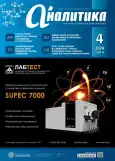Том 14, № 4 (2024)
Мнение
Быть нужными – самая большая ценность
Аннотация
ООО «НКЦ «ЛАБТЕСТ» на протяжении многих лет успешной деятельности интегрирует опыт и технические решения ведущих мировых производителей оборудования, которое используется в самых разных отраслях науки и производства.
Об основных направлениях, в которых трудятся специалисты компании, об изменившихся в последние годы условиях их работы, а также о планах коллектива на ближайшую перспективу журналу «АНАЛИТИКА» рассказал директор НКЦ «ЛАБТЕСТ» Александр Евгеньевич Каменщиков.
 278-284
278-284


Я не мог пройти мимо науки
Аннотация
Текущий 2024 год объявлен Годом семьи, и в связи с этим стали часто говорить о трудовых династиях. На страницах нашего журнала мы расскажем читателям о представителе одной из научных династий – Константине Всеволодовиче Григоровиче, российском ученом в области металлургии, металловедения, диагностики материалов, академике РАН, докторе технических наук, заведующем лабораторией диагностики материалов ФГБУН ИМЕТ им. А. А. Байкова РАН, профессоре кафедры металлургии стали, новых производственных технологий и защиты металлов НИТУ МИСиС.
Константин Всеволодович относится к третьему поколению династии Григоровичей, внесших весомый вклад в развитие отечественной науки как неотъемлемого фактора процветания нашей страны.
 286-296
286-296


Аналитические методы и приборы
Исследование широкого класса органических соединений методом хромато-масс-спектрометрии
Аннотация
Хромато-масс-спектрометрия – аналитический метод, основанный на сочетании возможностей хроматографии по разделению веществ и масс-спектрометрии, использующей для качественного и количественного определения отдельных компонентов в сложных смесях их спектральные характеристики. Приведены краткая историческая справка развития масс-спектрометрии, типы основных узлов масс-спектрометра и описание работы хромато-масс-спектрометра на примере прибора «Кристаллюкс-4000М» – «Маэстро-αМС», а также его технические характеристики. Перечислены области применения хромато-масс-спектрометра и некоторые конкретные методики измерения.
 302-310
302-310


Аналитика веществ и материалов
Хлорогеновая и кофейная кислоты: области применения и методы определения
Аннотация
Хлорогеновая и кофейная кислоты – одни из самых распространенных гидроксикоричных кислот. Они присутствуют в различных растениях, например, в кофе, чае и фруктах. Эти соединения активно исследуются на предмет их биологической активности и возможного применения для поддержания здоровья человека. В обзоре рассматриваются сферы применения кофейной и хлорогеновой кислот и методы их определения в различных объектах. Особое внимание уделяется источникам этих кислот, их биологической активности и влиянию на здоровье человека. Обсуждаются современные подходы к определению содержания кофейной и хлорогеновой кислот в пищевых продуктах, напитках и лекарственных средствах.
 312-321
312-321


Фотометрическое определение азокрасителей на основе карбо- и гетероциклических альфа-дикарбонильных соединений
Аннотация
До недавнего времени синтетические органические красители считались микрозагрязнителями из-за их низких концентраций в окружающей среде, однако последние данные свидетельствуют о том, что загрязнение красителями становится все более серьезной проблемой. Производственный процесс, определение качественных показателей продукции и требования к охране окружающей среды требуют аналитического контроля. В статье описаны новые азокрасители на основе карбо- и гетероциклических альфа-дикарбонильных соединений и приведены результаты их определения фотометрическим методом. Установлены оптимальные длины волн поглощения растворов соединений, удельные коэффициенты поглощения, пределы обнаружения и линейные диапазоны определения.
 322-326
322-326


Микро- и нанопластик. Абрис проблемы
Аннотация
Эта публикация – краткий обзор проблем, связанных с микро- (МП) и нанопластиком (НП) – мелкими полимерными частицами, загрязняющими окружающую среду и представляющими угрозу экосистемам и здоровью человека. Рассмотрены характеристики МП и НП, источники их попадания в окружающую среду, воздействие на живые организмы. Выделены различные области изучения МП и НП. При обилии проведенных работ наблюдается их некоторая фрагментарность, отсутствует единое и цельное понимание угроз здоровью человека.
 328-337
328-337


Страницы истории
М. С. Вигдергауз – ученый, организатор науки, создатель самарской хроматографической школы. К 90-летию со дня рождения
Аннотация
В этом году исполняется 90 лет со дня рождения выдающегося ученого с мировым именем, организатора науки, создавшего самую мощную хроматографическую школу в нашей стране, а также популяризатора хроматографии – науки, которой Марк Соломонович Вигдергауз посвятил всю свою жизнь. Научные интересы М. С. Вигдергауза охватывают все области хроматографии: от теории и практики газовой хроматографии до разработки хроматографических процессов с использованием неидеальных элюентов, неподвижных фаз и трансклассификационных вариантов хроматографии, основанных на использовании фазовых переходов в неподвижной и подвижной фазах. Марк Соломонович активно внедрял газо-жидкостную (ГЖХ) и капиллярную хроматографию в аналитический контроль, развивал применение газовой хроматографии в неаналитическом контроле и в промышленных процессах. Под его руководством создан один из первых ЭВМ-банков данных величин хроматографического удерживания более двадцати тысяч органических веществ, предложен минимальный набор предпочтительных неподвижных фаз с учетом условной хроматографической полярности. М. С. Вигдергауз предложил метод двойного внутреннего стандарта и другие методы расчета хроматограмм. Исследования ученого внесли заметный вклад в разработку газохроматографических методов анализа нефти и нефтепродуктов.
 338-342
338-342










